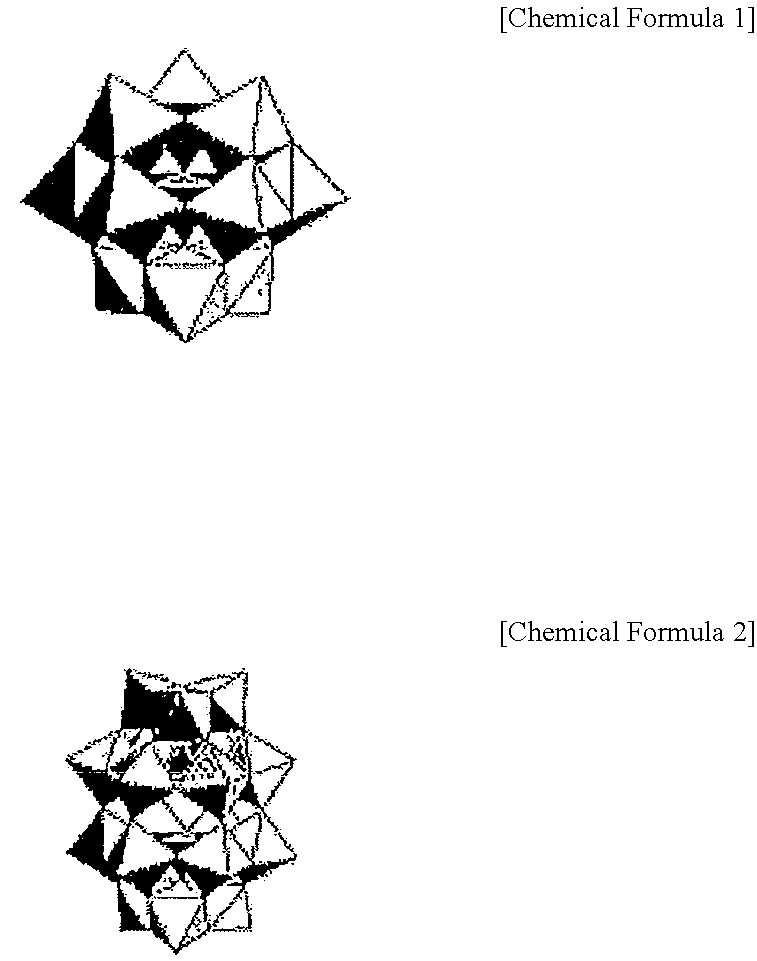Charge-transporting material and charge-transporting varnish
a charge-transporting varnish and charge-transporting technology, applied in the direction of phosphorus oxyacids, non-metal conductors, conductors, etc., can solve the problems of difficult to form a film with high uniformity, low molecular oligomer compounds, etc., to achieve excellent solubility, good solubility in organic solvents, and high flatness
- Summary
- Abstract
- Description
- Claims
- Application Information
AI Technical Summary
Benefits of technology
Problems solved by technology
Method used
Image
Examples
example 1
[0090]To 0.30 g of phosphomolybdic acid (H3PMo12O40.n-hydrate, made by Kanto Chemical Co., Inc.) was added 2.93 g of DMI (which is a good solvent) in a nitrogen atmosphere, thereby dissolving the acid. To this solution were added 1.47 g of propylene glycol and 4.40 g of cyclohexanol melted by heating to 40° C., and the resulting admixture was let cool to room temperature, to obtain a tan transparent solution.
[0091]The thus obtained solution was filtrated by use of a PTFE-made filter having a pore diameter of 0.2 μm, to obtain a tan transparent charge-transporting varnish (solids concentration: 3.3 wt %, viscosity: 11 mPa·s at 25° C.).
[0092]An ITO substrate having been subjected to ozone cleaning for 30 min was coated with the thus obtained varnish by a spin coating method, followed by baking on a hot plate at 220° C. in the atmospheric air for 30 min, to form a charge-transporting thin film. The thin film thus obtained was a uniform amorphous solid.
example 2
[0093]To 0.30 g of phosphotungstic acid (H3PW12O40.n-hydrate, made by Japan New Metals Co., Ltd.) was added 2.93 g of DMI (which is a good solvent) in a nitrogen atmosphere, thereby dissolving the acid. To this solution were added 1.47 g of propylene glycol and 4.40 g of cyclohexanol melted by heating to 40° C., and the resulting solution was let cool to room temperature, to obtain a tan transparent solution.
[0094]The thus obtained solution was filtrated by use of a PTFE-made filter having a pore diameter of 0.2 μm, to obtain a tan transparent charge-transporting varnish (solids concentration: 3.3 wt %, viscosity: 11 mPa·s at 25° C.).
[0095]An ITO substrate having been subjected to ozone cleaning for 30 min was coated with the thus obtained varnish by a spin coating method, followed by baking on a hot plate at 220° C. in the atmospheric air for 30 min, to form a charge-transporting thin film. The thin film thus obtained was a uniform amorphous solid.
example 3
[0096]To 0.30 g of phosphotungstomolybdic acid (H3PW6Mo6O40.n-hydrate, made by Japan New Metals Co., Ltd.) was added 2.93 g of DMI (which is a good solvent) in a nitrogen atmosphere, thereby dissolving the acid. To this solution was added 1.47 g of propylene glycol and 4.40 g of cyclohexanol melted by heating to 40° C., and the resulting solution was let cool to room temperature, to obtain a tan transparent solution.
[0097]The thus obtained solution was filtrated by use of a PTFE-made filter having a pore diameter of 0.2 μm, to obtain a tan transparent charge-transporting varnish (solids concentration: 3.3 wt %, viscosity: 11 mPa·s at 25° C.).
[0098]An ITO substrate having been subjected to ozone cleaning for 30 min was coated with the thus obtained varnish by a spin coating method, followed by baking on a hot plate at 220° C. in the atmospheric air for 30 min, to form a charge-transporting thin film. The thin film thus obtained was a uniform amorphous solid.
PUM
| Property | Measurement | Unit |
|---|---|---|
| viscosity | aaaaa | aaaaa |
| boiling point | aaaaa | aaaaa |
| boiling point | aaaaa | aaaaa |
Abstract
Description
Claims
Application Information
 Login to View More
Login to View More - R&D
- Intellectual Property
- Life Sciences
- Materials
- Tech Scout
- Unparalleled Data Quality
- Higher Quality Content
- 60% Fewer Hallucinations
Browse by: Latest US Patents, China's latest patents, Technical Efficacy Thesaurus, Application Domain, Technology Topic, Popular Technical Reports.
© 2025 PatSnap. All rights reserved.Legal|Privacy policy|Modern Slavery Act Transparency Statement|Sitemap|About US| Contact US: help@patsnap.com


